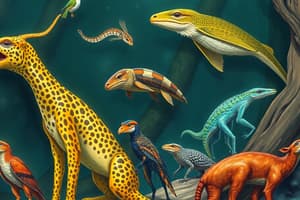Podcast
Questions and Answers
What is a common characteristic of all animals?
What is a common characteristic of all animals?
- They are prokaryotic organisms.
- All are unicellular.
- They produce collagen. (correct)
- They all have a coelom.
Which statement best explains the significance of the extracellular matrix (ECM) in animals?
Which statement best explains the significance of the extracellular matrix (ECM) in animals?
- The ECM forms the central nervous system.
- The ECM is only found in plants.
- The ECM is crucial for complex multicellularity. (correct)
- The ECM is primarily responsible for locomotion.
Which of the following phyla are classified under the supergroup Opisthokonta?
Which of the following phyla are classified under the supergroup Opisthokonta?
- Sponges and Fungi (correct)
- Fungi and Protozoa
- Arthropoda and Echinodermata
- Cnidaria and Annelida
What development stage follows the zygote in animal embryology?
What development stage follows the zygote in animal embryology?
Which type of symmetry is NOT typically used to describe animals?
Which type of symmetry is NOT typically used to describe animals?
Why is the presence of a body cavity important in higher animals?
Why is the presence of a body cavity important in higher animals?
Which of the following molecular components is NOT part of the extracellular matrix?
Which of the following molecular components is NOT part of the extracellular matrix?
Which characteristics distinguish Bilateria from other animal groups?
Which characteristics distinguish Bilateria from other animal groups?
Which characteristics are unique to cnidarians compared to sponges?
Which characteristics are unique to cnidarians compared to sponges?
What is the main function of the choanocytes in sponges?
What is the main function of the choanocytes in sponges?
Which statement about bilaterians is correct?
Which statement about bilaterians is correct?
In terms of their gut structure, how do cnidarians differ from sponges?
In terms of their gut structure, how do cnidarians differ from sponges?
Which group of animals is characterized by having a coelom and segmented bodies?
Which group of animals is characterized by having a coelom and segmented bodies?
What is a defining feature of molluscs?
What is a defining feature of molluscs?
What is the significance of metamerism in annelids?
What is the significance of metamerism in annelids?
How many species approximately belong to the phylum Porifera?
How many species approximately belong to the phylum Porifera?
Which characteristic is unique to Gastropoda among molluscs?
Which characteristic is unique to Gastropoda among molluscs?
Which class of molluscs is characterized by having two shell valves?
Which class of molluscs is characterized by having two shell valves?
What type of organism is primarily known for its ability to undergo ecdysis?
What type of organism is primarily known for its ability to undergo ecdysis?
Which of the following groups contains organisms that are known for being important soil components?
Which of the following groups contains organisms that are known for being important soil components?
Which characteristic is a defining feature of Tardigrada?
Which characteristic is a defining feature of Tardigrada?
In which environments are Tardigrada most commonly found?
In which environments are Tardigrada most commonly found?
Which phylum includes unsegmented round worms?
Which phylum includes unsegmented round worms?
What developmental stage is characteristic of lophotrochozoans?
What developmental stage is characteristic of lophotrochozoans?
What is a primary reason for the success of arthropods in various habitats?
What is a primary reason for the success of arthropods in various habitats?
Which substance primarily makes up the exoskeleton of arthropods?
Which substance primarily makes up the exoskeleton of arthropods?
How many times do arthropods typically molt before reaching adulthood?
How many times do arthropods typically molt before reaching adulthood?
What type of symmetry is associated with the phylum Echinodermata?
What type of symmetry is associated with the phylum Echinodermata?
What function does the water vascular system serve in echinoderms?
What function does the water vascular system serve in echinoderms?
Which of the following characteristics is NOT typically shared by chordates?
Which of the following characteristics is NOT typically shared by chordates?
Which subphylum includes the majority of living chordate species?
Which subphylum includes the majority of living chordate species?
What is the purpose of ecdysis in arthropods?
What is the purpose of ecdysis in arthropods?
What is the primary function of the notochord in chordates?
What is the primary function of the notochord in chordates?
Which of the following is NOT a characteristic of the subphylum Vertebrata?
Which of the following is NOT a characteristic of the subphylum Vertebrata?
Which structural feature is present in all chordates at some stage of development?
Which structural feature is present in all chordates at some stage of development?
What type of heart do most vertebrates have?
What type of heart do most vertebrates have?
What is a significant function of the dorsal nerve chord in chordates?
What is a significant function of the dorsal nerve chord in chordates?
Which of the following components is part of the excretory system in vertebrates?
Which of the following components is part of the excretory system in vertebrates?
Which of the following correctly describes the symmetry found in vertebrates?
Which of the following correctly describes the symmetry found in vertebrates?
What is the significance of the endocrine system in vertebrates?
What is the significance of the endocrine system in vertebrates?
Flashcards
What is an animal?
What is an animal?
A group of multicellular organisms that are heterotrophic, meaning they obtain nutrients by consuming other organisms.
What is bilateral symmetry?
What is bilateral symmetry?
A type of body plan where the body can be divided into two equal halves along a central axis.
What is radial symmetry?
What is radial symmetry?
A type of body plan where the body can be divided into multiple equal parts radiating from a central point.
Porifera
Porifera
Signup and view all the flashcards
Cnidaria
Cnidaria
Signup and view all the flashcards
Annelida
Annelida
Signup and view all the flashcards
Mollusca
Mollusca
Signup and view all the flashcards
Nematoda
Nematoda
Signup and view all the flashcards
Choanocyte in Sponges
Choanocyte in Sponges
Signup and view all the flashcards
Cnidocytes
Cnidocytes
Signup and view all the flashcards
Radial Symmetry
Radial Symmetry
Signup and view all the flashcards
Cephalization
Cephalization
Signup and view all the flashcards
Protostome Development
Protostome Development
Signup and view all the flashcards
Deuterostome Development
Deuterostome Development
Signup and view all the flashcards
Metamerism
Metamerism
Signup and view all the flashcards
Trochophore Larva
Trochophore Larva
Signup and view all the flashcards
What are Cephalopods?
What are Cephalopods?
Signup and view all the flashcards
What are Bivalves?
What are Bivalves?
Signup and view all the flashcards
What are Lophotrochozoans?
What are Lophotrochozoans?
Signup and view all the flashcards
What is Ecdysis?
What is Ecdysis?
Signup and view all the flashcards
What are Nematodes?
What are Nematodes?
Signup and view all the flashcards
What are Tardigrades?
What are Tardigrades?
Signup and view all the flashcards
What is an exoskeleton?
What is an exoskeleton?
Signup and view all the flashcards
What is Metamorphosis?
What is Metamorphosis?
Signup and view all the flashcards
Exoskeleton
Exoskeleton
Signup and view all the flashcards
Ecdysis (Molting)
Ecdysis (Molting)
Signup and view all the flashcards
Chitin
Chitin
Signup and view all the flashcards
Echinodermata
Echinodermata
Signup and view all the flashcards
Water Vascular System
Water Vascular System
Signup and view all the flashcards
Notochord
Notochord
Signup and view all the flashcards
Dorsal Tubular Nerve Chord
Dorsal Tubular Nerve Chord
Signup and view all the flashcards
Pharyngeal Pouches
Pharyngeal Pouches
Signup and view all the flashcards
What is the notochord?
What is the notochord?
Signup and view all the flashcards
What is a postanal tail?
What is a postanal tail?
Signup and view all the flashcards
Vertebrates (Craniata)
Vertebrates (Craniata)
Signup and view all the flashcards
Tunicata & Cephalochordata
Tunicata & Cephalochordata
Signup and view all the flashcards
Subphylum Vertebrata
Subphylum Vertebrata
Signup and view all the flashcards
Muscular Perforated Pharynx
Muscular Perforated Pharynx
Signup and view all the flashcards
Endocrine Glands
Endocrine Glands
Signup and view all the flashcards
Study Notes
Animal Diversity
- Animals are described by their body symmetry (size and shape of body parts along an axis or plane)
- Animals have an extracellular matrix, often forming a scaffolding
- Classification of life on Earth includes three domains: Bacteria, Archaea, Eukaryota
- Supergroup Opisthokonta includes animals, fungi, and some protozoa
- Phyla of animals are characterized by features such as Porifera, Cnidaria, Annelida, Mollusca, Nematoda, Arthropoda, Echinodermata, and Chordata
Three Domains of Life
- Life on Earth is divided into Bacteria, Archaea, and Eukaryota
- Bacteria and Archaea are prokaryotes
- Eukaryota includes cells with nuclei
Supergroup Phylogeny of Eukaryotes
- Supergroup Opisthokonta includes multicellular animals, fungi, and some protists
Porifera (Sponges)
- 5,000 species
- Primarily marine
- Simple anatomical organization, no tissues
- Specialized cells (choanocytes) to feed
Cnidaria (Jellyfish, Anemones, Corals)
-
9,000 species
- Marine and freshwater
- Radial symmetry
- Stinging cells (cnidocytes)
- Incomplete digestive system
Bilateria
- Generally predators
- Distinct head and tail (cephalization)
- Clustering of sense organs on the anterior end (forward-facing)
- Often have a mouth at the anterior and an anus at the posterior end
Protostomes
- Lophotrochozoa
- Ecdysozoa
- Include annelid and mollusk worms
- Include "lophophre": organ for filter feeding
- Trochophore: a type of larva
Mollusks
- ~100,000 species
- Includes snails, slugs, clams, mussels, oysters, squids, and octopuses
- Distinguishing features: mantle, trochophore larva
- Gastropod, Cephalopod, Bivalvia classes
Annelids
- ~100,000 species
- Segmented worms
- Includes snails, slugs, clams, mussels, oysters, squids, octopuses
Nematoda (Roundworms)
- 25,000 species
- Most numerous animals
- Found in all habitats
- Important for soil communities
- C. elegans is a well-studied species
- Many are parasites
Tardigrada
- 1,300 species
- Microscopic
- Found in various moist environments
- Extremely resilient to harsh conditions
Arthropods
- ~1.2 million species
- Jointed appendages
- Exoskeleton with chitin
- Metamorphosis
- Extremely diverse
- Highly successful group
Echinoderms
- 7,000 species
- Radial symmetry (pentaradial)
- Water vascular system
- Includes sea stars, urchins, and sea cucumbers
Chordata
-
81,000 species
- Include the vertebrates
- Notochord
- Dorsal tubular nerve chord
- Pharyngeal pouches
- Postanal tail
Craniata/Vertebrates
- Vertebral column
- Craniums
- Well-developed sense organs and systems
- Endocrine system
- Includes fish, amphibians, reptiles, mammals, and birds
Studying That Suits You
Use AI to generate personalized quizzes and flashcards to suit your learning preferences.




